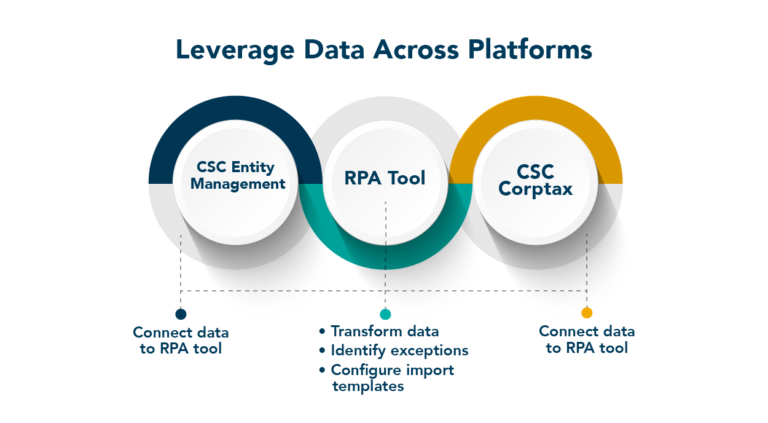While many tax processes have calmed down since the latest round of tax reform, international compliance isn’t one of them. Challenges around GILTI only compound when you layer in FDII, Subpart F, and foreign tax credits. Changes to one item can cascade throughout your entire international process. Add a tight close window, and challenges abound.
Tax automation and the right system architecture help you control your close process and prevent issues before they arise. Read on as I explain how.
Why System Architecture Matters
CSC Corptax® and other tax software products can account for GILTI, FDII, foreign tax credit, etc., but in order for automation to be most effective, data should be organized, seamlessly processed, and saved in a way that lends itself to reporting. That’s what we refer to as architecture.
Saving and storing your data in a dedicated tax system prevents the dreaded “black box” of not understanding how calculations were performed. You need transparency to understand each step and report the output. In this way, automation and architecture go hand-in-hand.
For example, to calculate your GILTI inclusion, your tax software should save and store data throughout each step.
- Step 1: Process GILTI at the CFC (controlled foreign corporation) level
- Step 2: Track functional currency and ownership information
- Step 3: Aggregate and roll up data to your shareholders
- Step 4: Post calculated results to your CFCs’ E&P pools

Standardize Data to Increase Automation
Let’s briefly discuss benefits achieved using system architecture to standardize your tax data. For starters, what should you consider?
Organizing data with common profiles provides opportunities for automation, as do common datasets and adjustments, and accounts to use across your provision, compliance, and planning lifecycle. Often, it’s simply a matter of reviewing your tax process and better understanding your data.
For example, I recently worked with a client on streamlining their foreign data collect packages. The client calculated and stored data in a U.S. GAAP ledger—and also recorded all adjustments into a statutory ledger. By loading both of those ledgers—the U.S. GAAP ledger into one dataset and the statutory ledger into another dataset—they were both aligned with a common set of accounts. We then applied automation to calculate the difference between the GAAP and STAT ledgers to post the automated adjustments.
Instead of reconciling from the U.S. GAAP income, the foreign controllers were able to start with their statutory income and reconcile down to the tax they owed. This simplified and streamlined the process. Adopting common standards like these increases their ability to automate.
Common data profiles also apply to items beyond trial balance and book to tax adjustments. For instance, entity information such as tax status, ownership, and currency need to be maintained in your software to calculate your GILTI inclusion.
Standardized profiles reduce other pain points as well. If you automate or standardize adjustments across provision and compliance, you can line those up—making return-to-provision a simple output of comparing the two datasets. Similarly, if you map all your adjustments to your balance sheet, your software will maintain a tax basis balance sheet for you. Taking the time to define items in an orderly fashion yields numerous automation efficiencies.
Robotic Process Automation Ramps Up Efficiencies
Moving on to automating steps in a process, I often ask clients, “How many steps within your close or compliance process can you execute step by step that can be triggered by an initial event?”
Most people think about loading a trial balance into a system and having that kick off automated adjustments, like E&P or book-to-tax adjustments. But other actions can happen that way, too. For example, after E&P and book-to-tax adjustments are processed, international calculations can process. Those international calculations can post to your provision dataset. In the provision dataset, you can calculate federal, state, and foreign provisions at the same time.
The key is to break apart and look at your process, define step-by-step tasks you do regularly, and use automation to execute the steps en masse. This not only reduces time spent, but the level of risk in your processes.
Here are several other BOTS advantages:
- Automate updates to audit packages when data and calculations change
- Automate return packages as returns are completed
- Post automated adjustments including export to Excel workpapers
- Consolidate book-to-tax audit packages
- Create rules-based advanced queries to reuse data throughout the tax lifecycle
Define and Leverage Business Rules Across Your Tax Lifecycle
Now, let’s touch on leveraging rules from one phase of your tax lifecycle to the next. Use sourcing and apportionment rules for compliance and then apply or ‘copy them over’ to reuse for provision.
You also have the ability to define where output is posted. For example, create a rule to automate non-deductible expenses. Apply the same rule and post it to a compliance, provision, or planning case.
And finally, it’s easier than ever to get data into and out of a tax system to help you visualize data in dashboards and improve planning. Tools like open database connectivity (ODBC) drivers and Web API provide real-time connections to external analytics programs such as Alteryx and Tableau.
To illustrate, the graphic below shows how a company can export both entity and tax data into an RPA tool and transform that data by comparing it on an apples-to-apples basis. You can determine exceptions and load those exceptions back into your tax system. You keep the two systems 100% in sync. Not only will you save a lot of time—you’ll save substantial risk.

Connect to your data using API/ODBC tools, then use RPA to define process steps and rules, then automate reconciliations and exceptions.
Tax Software and System Architecture Make a Big Difference
Multinational companies often grapple with compressed close cycles while juggling new technical rules and regulations. Tax automation cuts through the complexity and enables companies to better manage risk.
The more you accomplish prior to your close window, and the more rules you create and apply in your software, the more time and errors you’ll save. By breaking down your close process, understanding what can occur together, and using automation tools like BOTS to accelerate them, efficiencies multiply. The result? Less time spent on routine tasks and more time spent on value drivers like analytics and planning.
Need international compliance assistance? Consult with an expert! Contact CSC Corptax at 800.966.1639 or info@corptax.com.
Watch the webinar to achieve the 3 ‘As’ of International Compliance: Automation, Acceleration, Accuracy!
about this topicAbout Eric Williams
A thought leader and industry contributor, CSC Corptax® Senior Manager Eric Williams regularly speaks at Tax Executives Institute (TEI) and ACT’s Technology Annual Conference. He specializes in international compliance and ASC 740. Eric is a licensed CPA and holds both a Master of Science and a Bachelor of Business Administration in Accounting from Texas A&M University.
